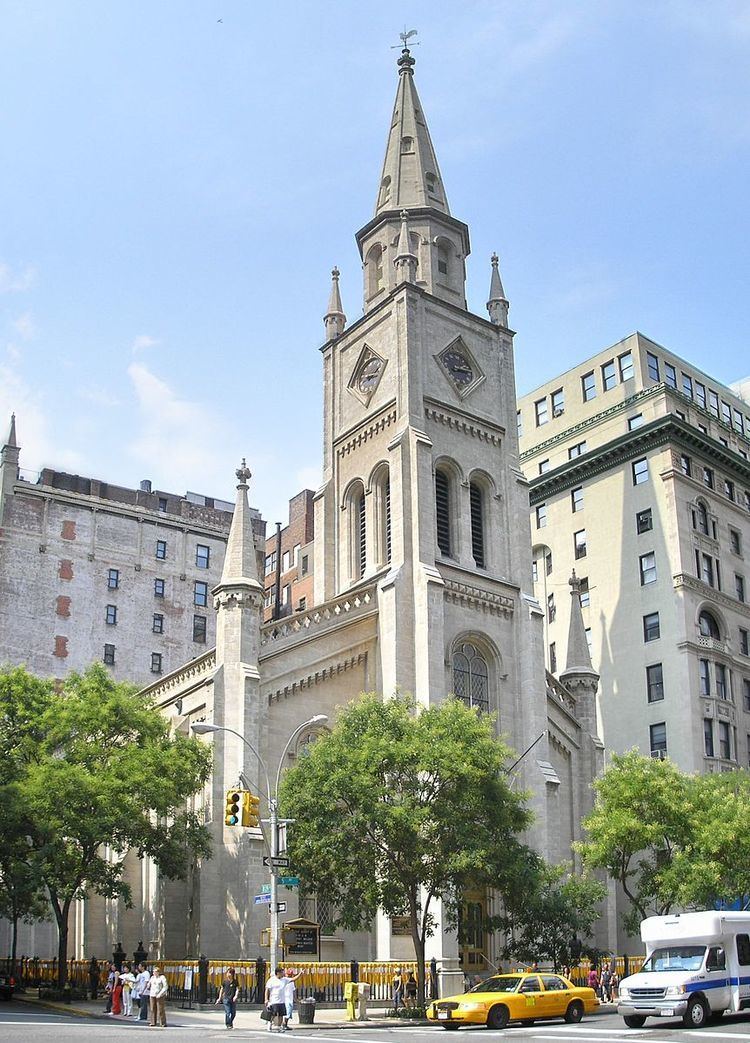Built 1851 Designated NYCL January 11, 1967 Area 3,642 m² Added to NRHP 9 April 1980 | NRHP Reference # 80002699 Opened 1851 Phone +1 212-686-2770 | |
 | ||
Address 1 W 29th St, New York, NY 10001, USA Architectural style Romanesque Revival architecture Similar New Middle Collegiat, Church of the Transfigu, West End Collegiate Church, Fort Washington Collegiat, Gilsey House Profiles | ||
The Marble Collegiate Church, founded in 1628, is one of the oldest continuous Protestant congregations in North America. The congregation, which is part of the Reformed Church in America, is now located at 272 Fifth Avenue at the corner of West 29th Street in the NoMad neighborhood of Manhattan, New York City. It was built in 1851–54 and was designed by Samuel A. Warner in Romanesque Revival style with Gothic trim. The facade is covered in Tuckahoe marble, for which the church, originally called the Fifth Avenue Church, was renamed in 1906.
The building was designated a New York City landmark in 1967, and in 1980 was added to the National Register of Historic Places.
History
The church congregation was founded in 1628 as the Collegiate Reformed Protestant Dutch Church and was affiliated with the Dutch Reformed Church, a Calvinist church in the Netherlands. During its first 150 years, Marble shared its ministers with the other Collegiate congregations as they developed in the city. This pooling of pastoral ministry was abandoned in 1871. The name "Collegiate" remains as part of the heritage of the four such churches in New York City today, and they participate in an administrative unit that oversees physical properties and investments held in common. The other congregations are Middle Collegiate, West End Collegiate, and Fort Washington Collegiate.
Norman Vincent Peale, the noted author of The Power of Positive Thinking, served as senior minister from 1932 to 1984. Under his ministry Marble's influence reached national levels and became known as "America's Hometown Church". On November 19, 1961, Lucille Ball married her second husband Gary Morton in the church. Following Peale's fifty-two year ministry, Arthur Caliandro served 25 years as the fifth senior minister of Marble Church. In all, he served 42 years on the pastoral staff. During Caliandro's tenure, MarbleVision, the media ministry of Marble Church, was founded, its first woman minister was ordained, and the first women elders received. In addition, the church added its first new stained-glass window in almost 100 years. In 2009, Michael B. Brown, former pastor of Centenary United Methodist Church in Winston-Salem, North Carolina, succeeded Caliandro as senior minister.
During his successful 2015–16 run for the Republican Party's presidential nomination, President Donald Trump told a 2015 South Carolina campaign audience that he attends Marble Collegiate Church. The church is where he was married by Dr. Peale to his first wife, Ivana Trump, in 1977. In 1993, Marble's Minister Dr. Arthur Caliandro, performed Trump's marriage to Marla Maples in the Grand Ballroom of the Plaza Hotel owned at the time by Trump. Marble has said that though he has a history with the church, Trump has stated that he is a Presbyterian and is not currently an active member of Marble's congregation.
The church takes an 'affirm' approach to same-gender relationships and non-cisgender identities. This includes the performing of same-sex marriage ceremonies, a designated queer fellowship (GIFTS), annual participation in the NYC Pride parade and sermons and material on the church website encouraging a modern scholarly view of Scripture in opposition to the conservative Protestant belief in 'God's literal and inerrant Word' which results in heteronormative and arguably homophobic interpretations.
